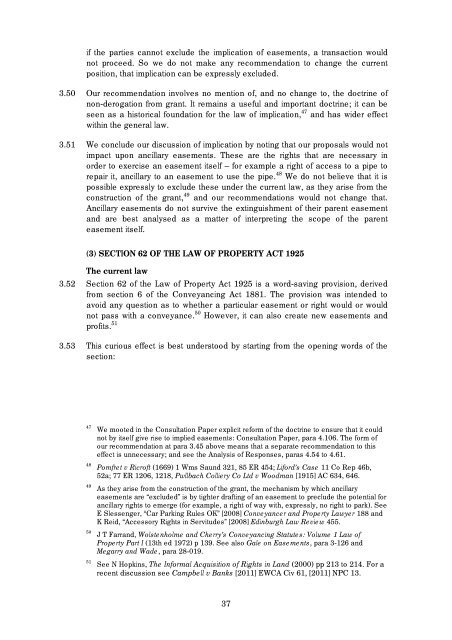Making Land Work: Easements, Covenants and ... - Law Commission
Making Land Work: Easements, Covenants and ... - Law Commission
Making Land Work: Easements, Covenants and ... - Law Commission
Create successful ePaper yourself
Turn your PDF publications into a flip-book with our unique Google optimized e-Paper software.
if the parties cannot exclude the implication of easements, a transaction would<br />
not proceed. So we do not make any recommendation to change the current<br />
position, that implication can be expressly excluded.<br />
3.50 Our recommendation involves no mention of, <strong>and</strong> no change to, the doctrine of<br />
non-derogation from grant. It remains a useful <strong>and</strong> important doctrine; it can be<br />
seen as a historical foundation for the law of implication, 47 <strong>and</strong> has wider effect<br />
within the general law.<br />
3.51 We conclude our discussion of implication by noting that our proposals would not<br />
impact upon ancillary easements. These are the rights that are necessary in<br />
order to exercise an easement itself – for example a right of access to a pipe to<br />
repair it, ancillary to an easement to use the pipe. 48 We do not believe that it is<br />
possible expressly to exclude these under the current law, as they arise from the<br />
construction of the grant, 49 <strong>and</strong> our recommendations would not change that.<br />
Ancillary easements do not survive the extinguishment of their parent easement<br />
<strong>and</strong> are best analysed as a matter of interpreting the scope of the parent<br />
easement itself.<br />
(3) SECTION 62 OF THE LAW OF PROPERTY ACT 1925<br />
The current law<br />
3.52 Section 62 of the <strong>Law</strong> of Property Act 1925 is a word-saving provision, derived<br />
from section 6 of the Conveyancing Act 1881. The provision was intended to<br />
avoid any question as to whether a particular easement or right would or would<br />
not pass with a conveyance. 50 However, it can also create new easements <strong>and</strong><br />
profits. 51<br />
3.53 This curious effect is best understood by starting from the opening words of the<br />
section:<br />
47 We mooted in the Consultation Paper explicit reform of the doctrine to ensure that it could<br />
not by itself give rise to implied easements: Consultation Paper, para 4.106. The form of<br />
our recommendation at para 3.45 above means that a separate recommendation to this<br />
effect is unnecessary; <strong>and</strong> see the Analysis of Responses, paras 4.54 to 4.61.<br />
48 Pomfret v Ricroft (1669) 1 Wms Saund 321, 85 ER 454; Liford’s Case 11 Co Rep 46b,<br />
52a; 77 ER 1206, 1218, Pwllbach Colliery Co Ltd v Woodman [1915] AC 634, 646.<br />
49 As they arise from the construction of the grant, the mechanism by which ancillary<br />
easements are “excluded” is by tighter drafting of an easement to preclude the potential for<br />
ancillary rights to emerge (for example, a right of way with, expressly, no right to park). See<br />
E Slessenger, “Car Parking Rules OK” [2008] Conveyancer <strong>and</strong> Property <strong>Law</strong>yer 188 <strong>and</strong><br />
K Reid, “Accessory Rights in Servitudes” [2008] Edinburgh <strong>Law</strong> Review 455.<br />
50 J T Farr<strong>and</strong>, Wolstenholme <strong>and</strong> Cherry’s Conveyancing Statutes: Volume 1 <strong>Law</strong> of<br />
Property Part I (13th ed 1972) p 139. See also Gale on <strong>Easements</strong>, para 3-126 <strong>and</strong><br />
Megarry <strong>and</strong> Wade, para 28-019.<br />
51 See N Hopkins, The Informal Acquisition of Rights in <strong>L<strong>and</strong></strong> (2000) pp 213 to 214. For a<br />
recent discussion see Campbell v Banks [2011] EWCA Civ 61, [2011] NPC 13.<br />
37
















